2008 VOLKSWAGEN GOLF tire size
[x] Cancel search: tire sizePage 335 of 444
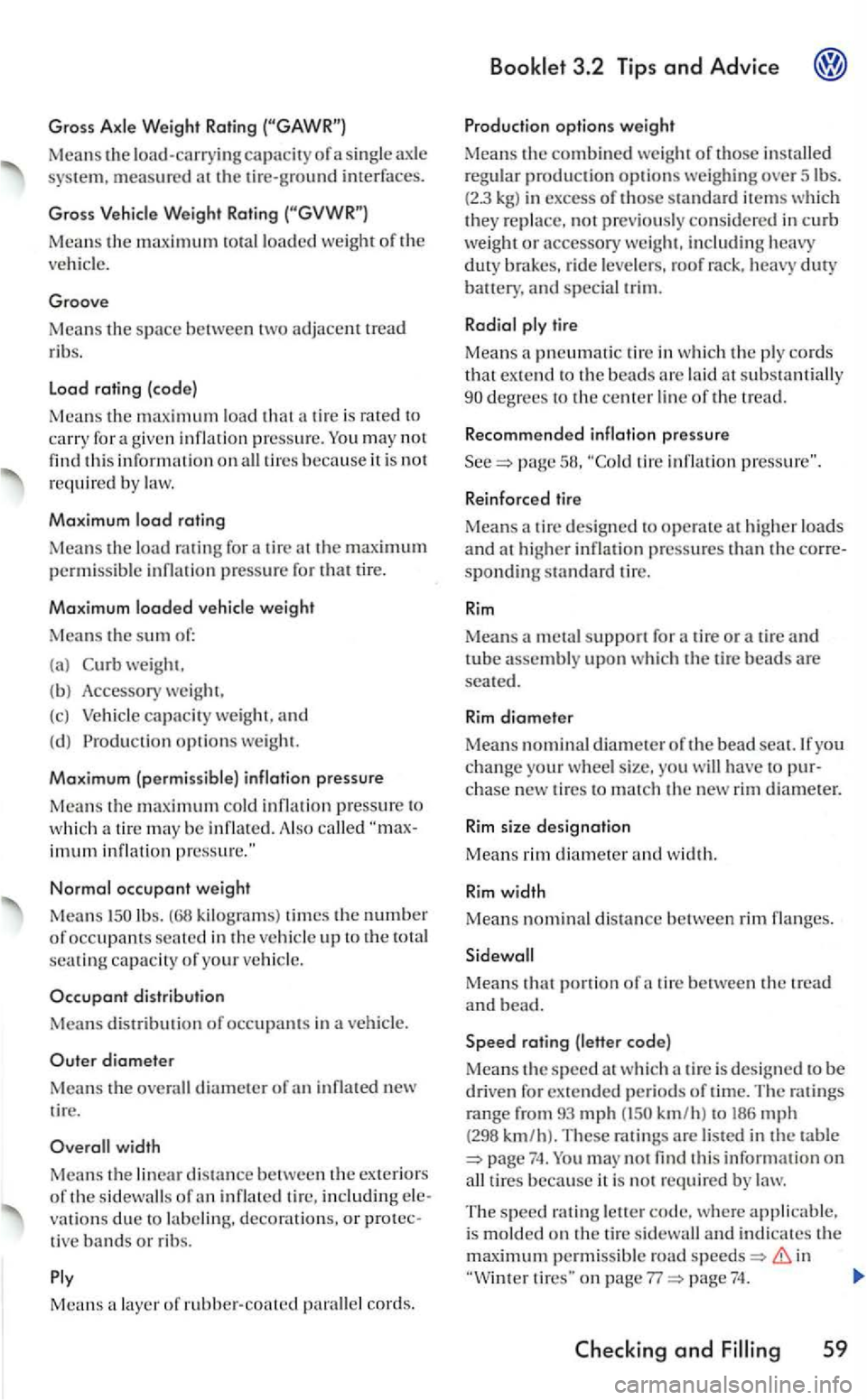
Gross Axle W eight Ra ting
Mea ns the load-carryin g capacity of a sing le ax le
Mean s th e maximumlOtalloaded weight of the
ve hicle.
Groove
Means the space between adjacent tread
r ib s.
L
oad ratin g (cod e)
Means the load th at a tire is rated to
carry for a give n inflation pressure. You may no t find thi s information o n all tires because it is not require d b y
Maximum load ratin g
Means the load rating for a tire the m aximum permiss ib le inflation p ressure for that tire.
Maximum loaded vehicle weig ht
Means th e sum of:
( a)
weig ht.
( b ) Accessory
weight,
(c) Vehicl e capacity weig ht. and
(d ) Production o pti ons
b e inflat ed. A lso called imum inflatio n pressure."
Normal oc cupant weight
Means lb s. kilog ra ms} times the n u m ber of occupants sea te d i n the ve hicl e up to the seating capacity of your vehicle.
O c
cupant distr ib ution
Means dist ributio n of occupants in veh icle.
Outer d iameter
Means the overall diameter of an inflated new tir e.
inflated including vations due to or tive bands or rib s.
P ly
M
ean s layer uf parallel cord s.
Productio n optio ns weight
Means the com bined weight of those installed
regular produc tion options weighing over Sibs. (2.3 kg) in excess of those standard items whic h they replace, not previously considered in curb weight or accessory
pne u matic tire in which the pl y cords th at ex tend to the beads a rc laid at substa n tially degrees to the center lin e of the tread.
Re commended inflat io n p ressure
page tire inflation p ressure".
Reinforc
ed tir e
Means a tire designed to operate at higher loads and at higher inflation pressures than the sponding tire.
Rim
Means a m etal support for a tire or a tire and tube assembly upon whic h the tire beads are seate d .
Rim d iameter
Means nominal diameter oft he bead seal. you change your w heel size. you will have to
Means that portion of tire between the tread
and bead.
which
km/h) mph ( 298 k.m/ h ). These rat ings are lis ted in the table 74. You may not find this information on all tire s because it is not required by law.
The speed r ating lett er cod e, where is molded on the tir e s idewall and indicates the maxjmurn permissible road in on page 77 74.
Checking and
Page 337 of 444
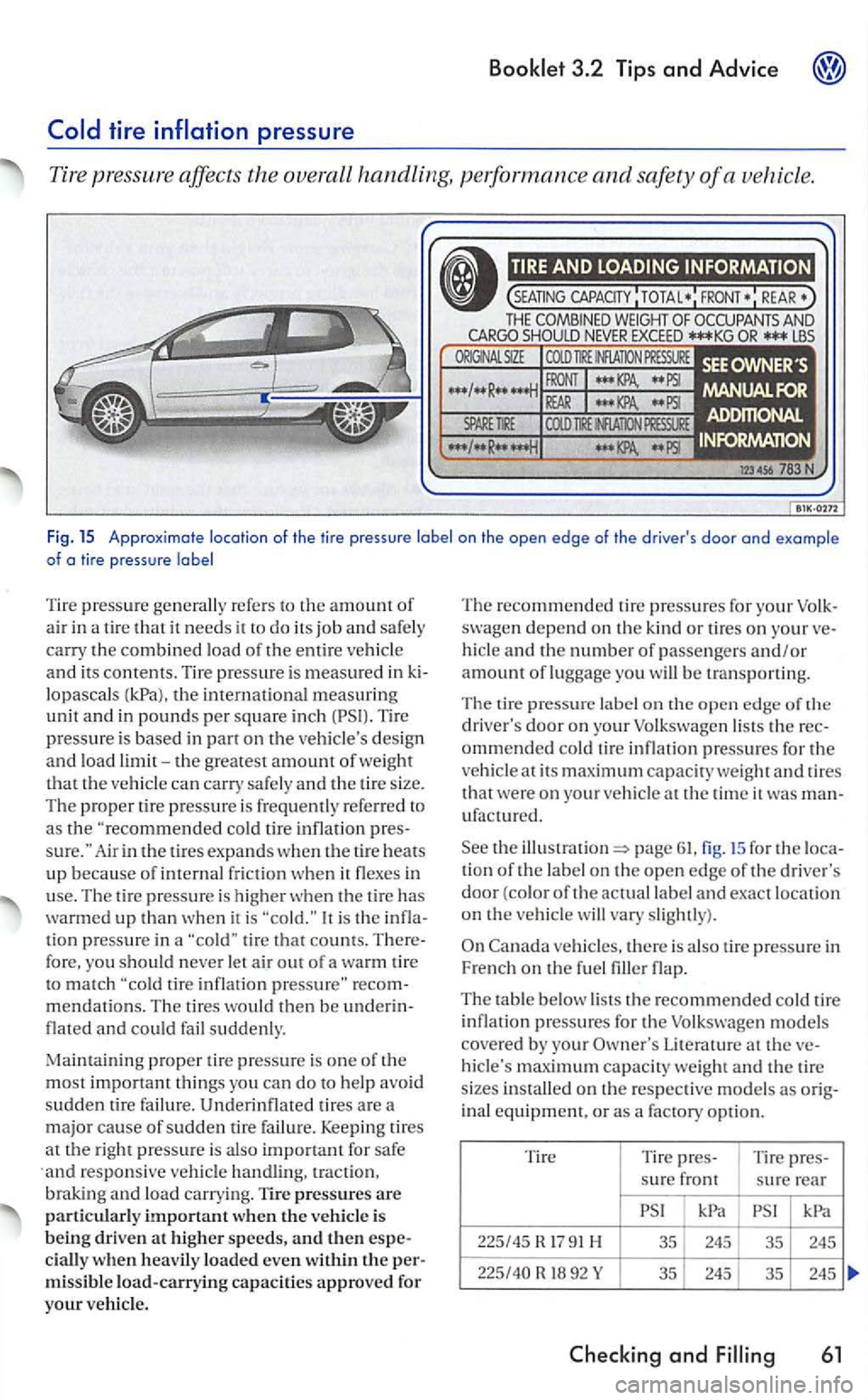
3.2 Tips and Advice
refers to the amount of air in a tire that it needs it to do its job and safe ly carry the combined load of the entire
on the d esign and load limit-the greatest amount of we ight that the can carry safel y and the tire size.
Th e proper lire pressure is frequently re ferred to a s the "recommended co ld tire inflation
It is the tion pre ssure in a tire that counts .
respo nsiv e
is being driven at higher speed s, and th e n cially w hen heavily loaded even within the missible load-carrying capacit ies approved for your vehicl e. T
he r
ecommended tire pressures for your d epend on the kind or tires on your h icl e and the number of passengers and/or amount ofluggage you will be t ransporting.
Th e tire
pressure label on the open ed ge of th e
driver's door on your Volk swagen lists the ommended co ld tir e infl ation pressures for the
at th e tim e it was ufactured.
page fig. 15 for the tion of the label on the open edge of the driver's door (colo r of the actual label and exact locat ion on the
flap.
The table below lists the recommended cold tire
i nflatio n pressures for the models covered by your maximum capacit y we igh t and th e tire
sizes on t h e res pective models as inal equipment, or as a factory opti on.
T ir e Tire
pres-Tire pres-
s ur e front sure rear
kPa
17 91 35 245 35 245
6
1
Page 338 of 444
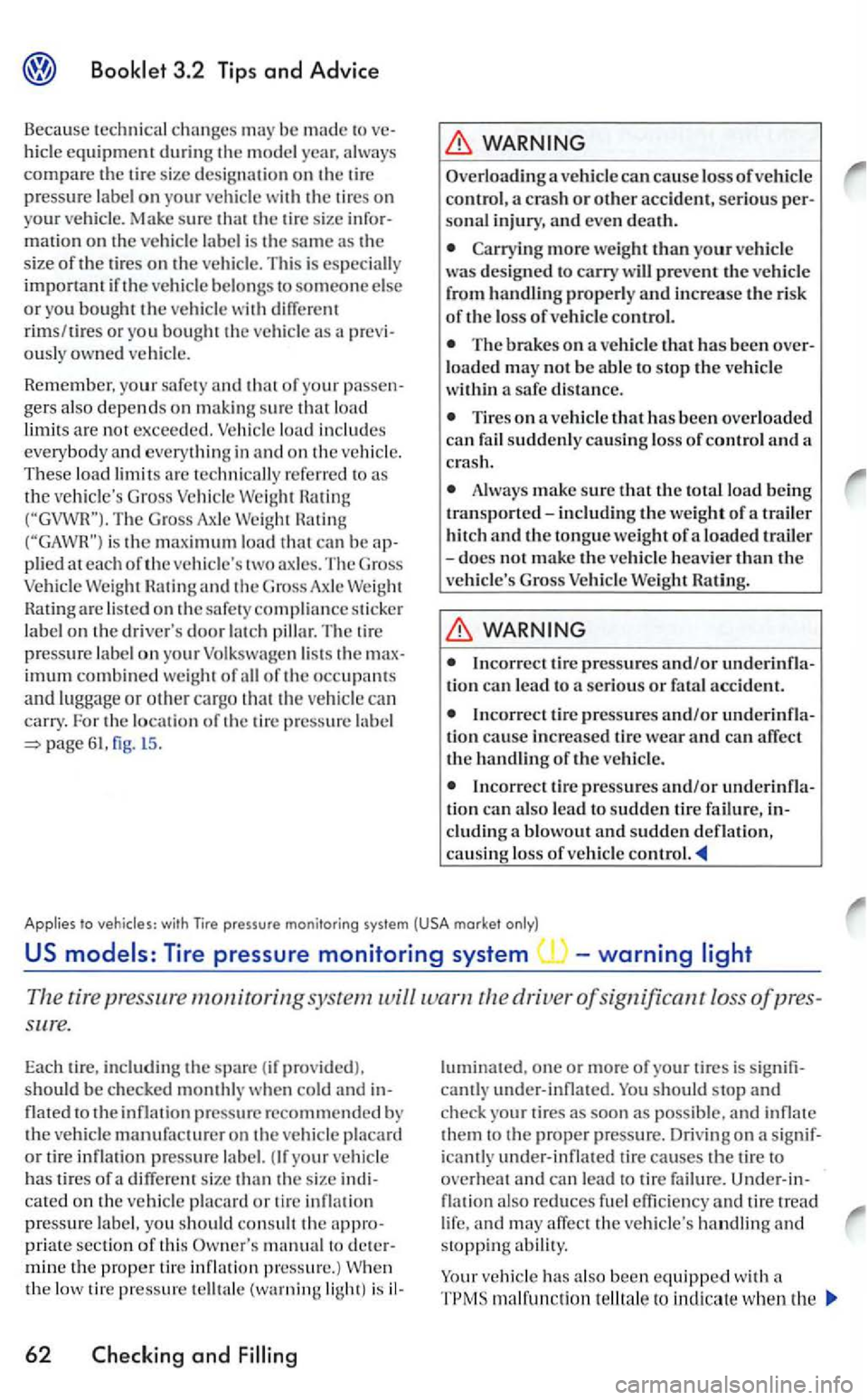
3.2 Tips and Advice
Because technical changes may be made to vehicle equipment during the model year, always compare the tire size desig nation on the tir e pressure label on your vehicle with the tire s on your vehicle. Make sure
a previousl y owned ve hicle.
Remember, your safe ty and t h at of your passengers also depends on making sure that load
limit s are not exceeded. Vehicle load includes everybody and everything in and on the vehicle.
T hese load limit s arc techni call y referred to the ve hicle's Gross Vehicl e Rating Hatin g is th e maximum load that
Hating are listed on th e s afet y compliance sticker
label on t h e driver's door
fig. l5 .
WARNING
Overloading a vehicl e can cause loss of vehicle control,
more we ight than your vehicle was des ign ed to carry w ill prevent the vehicle from handling properly and increase the risk of the loss of vehicle control.
The on a vehicle that has been over
loaded may not be abl e to stop the vehicle within a safe distance.
Tires on a vehicle that has been overloaded can fail suddenly cau sin g loss of control and a crash.
Always make sure that the total load being transp o rted-including the weight of a trailer hitch and the to ng u e weight of a loaded trailer -docs not make the vehicle heavie r than the vehicle's Gross Vehicle
WARNING
Inco rrect tire pressures and/or underinflation can lead t o serious or fata l accident.
Incorrect tire pressures and/or underinflation cause increased tire wear and can affect the ha nd lin g of the ve hicle.
Applies to
The tire pressur e monitoring syste m driver ofsignificantloss of pres
sure.
Each tire, including the spare ( if provided),
should be c heck ed
your vehicle has tire s of a diff erent s ize than the s ize indi cated on the vehicle placard or tire inflation pressure lab el, you should consult the appropriate sec tion of this
and
luminatcd. one or m ore of your tires is signifi
cantly under-inflated. should stop and check your tires as soon as possible , and inflate them to the pro p er p ressure. Driving on a sig nif
icantly under- inflated tire causes the tire to overheat and can lead to tire failure. Under- in-
flation al so reduces fuel effic iency and tire tread life , and may affe ct th e vehic le's handling stopping ability.
ve hicle has also been equipped with a malfunction te llt ale to indi cate when
Page 353 of 444
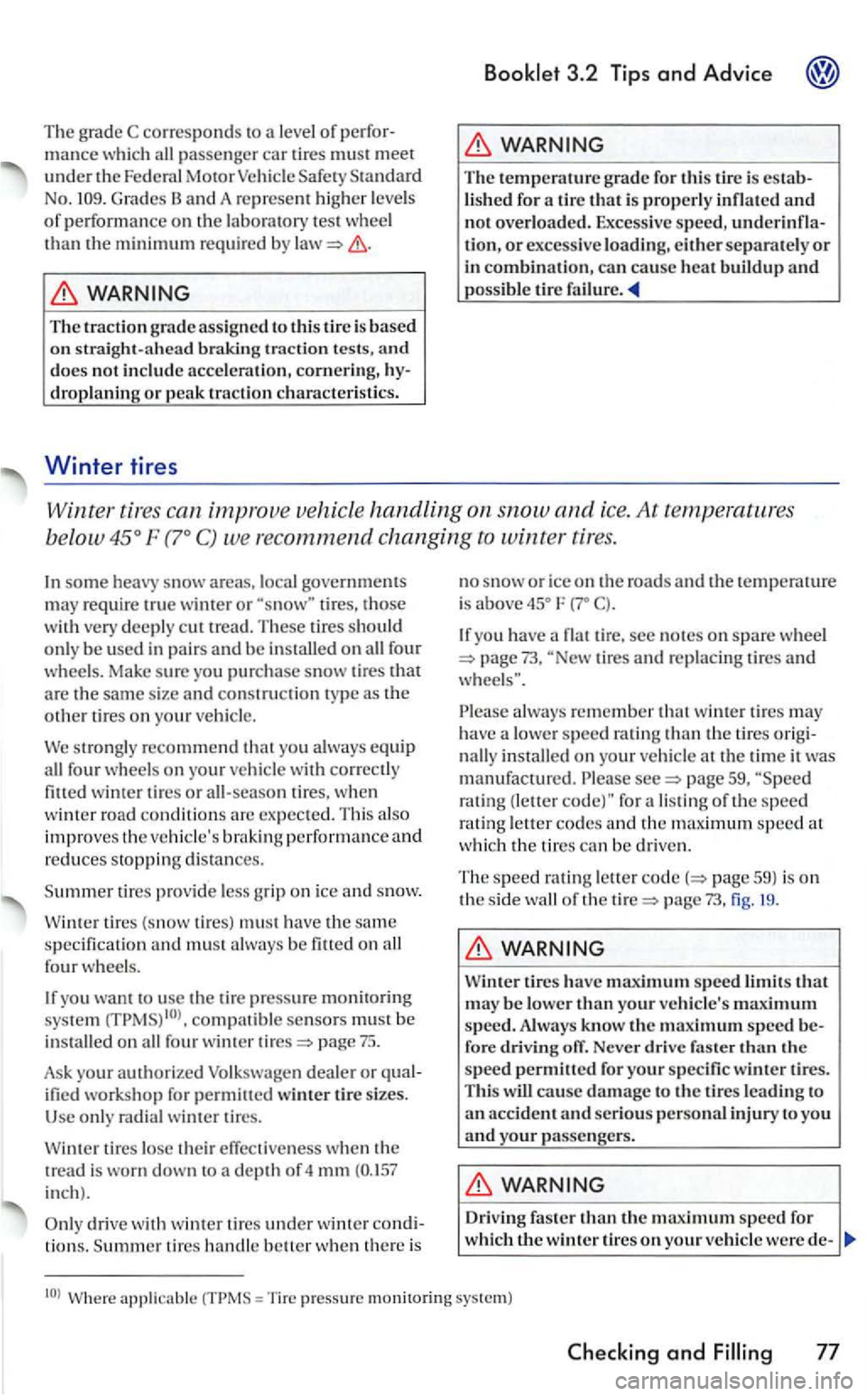
The g rad e C corresponds to a level of passe nger car tires must meet under the Federa l Motor G rades
trac tion tests, does not acceleration, cornerin g, droplaning or peak traction ch aracteristics.
Winter tire s
3.2 Tips and Advice
Winter tires can improve vehicle handling on snow and ice. At temperatures
b elow
F
some heav y snow areas, local governments may require true w inter or tires, those with very deeply cut trea d. T hese tires should only be used in pair s and be installed on fou r
wheels. Make sure you purchase snow tires that are the same size and construction type as th e
other tires on your
fou r wheels on you r
performance and reduces stoppin g di stances.
S
ummer tire s provide less grip on ice and snow.
tires (snow tir es) must have th e same specification and must always be fille d on four wheels.
yo u want to usc the tire pressure monitoring system compatibl e sensors must be ins talled on fou r winte r page
dealer or
tires lose their effectiveness when the tread is worn down to a dept h of 4 mm inch).
drive with winter tires under winter tion s. Summe r tire s handl e whe n th ere is n
o s
now or ice on the roads and the temperature is above F C).
you have a sec notes on spare wheel 73, tires and replacing tires and
alway s remember that winter tires may have a lower speed rati ng than the tires installed on your veh icle at the time it was manufactured. page 59, rating (letter for listin g oft he speed
r at ing le tt er
codes and the maximum speed at
w hi ch the t ires can be driven.
The speed ratin g le tter page 59) is o n
t h e s ide of th e page 73, fig. 19.
tires have maximum speed that may be lower than your m aximum speed. Always know the maximum speed fo re driving off. Never drive faster than the
s peed permilled fo r your specific winter tire s.
T his will cause damage to the t ires leadin g to an accident and serious pe rsonal injury to you and your passe nge rs.
= Tire press ure monito ring sys tem )
and
Page 354 of 444
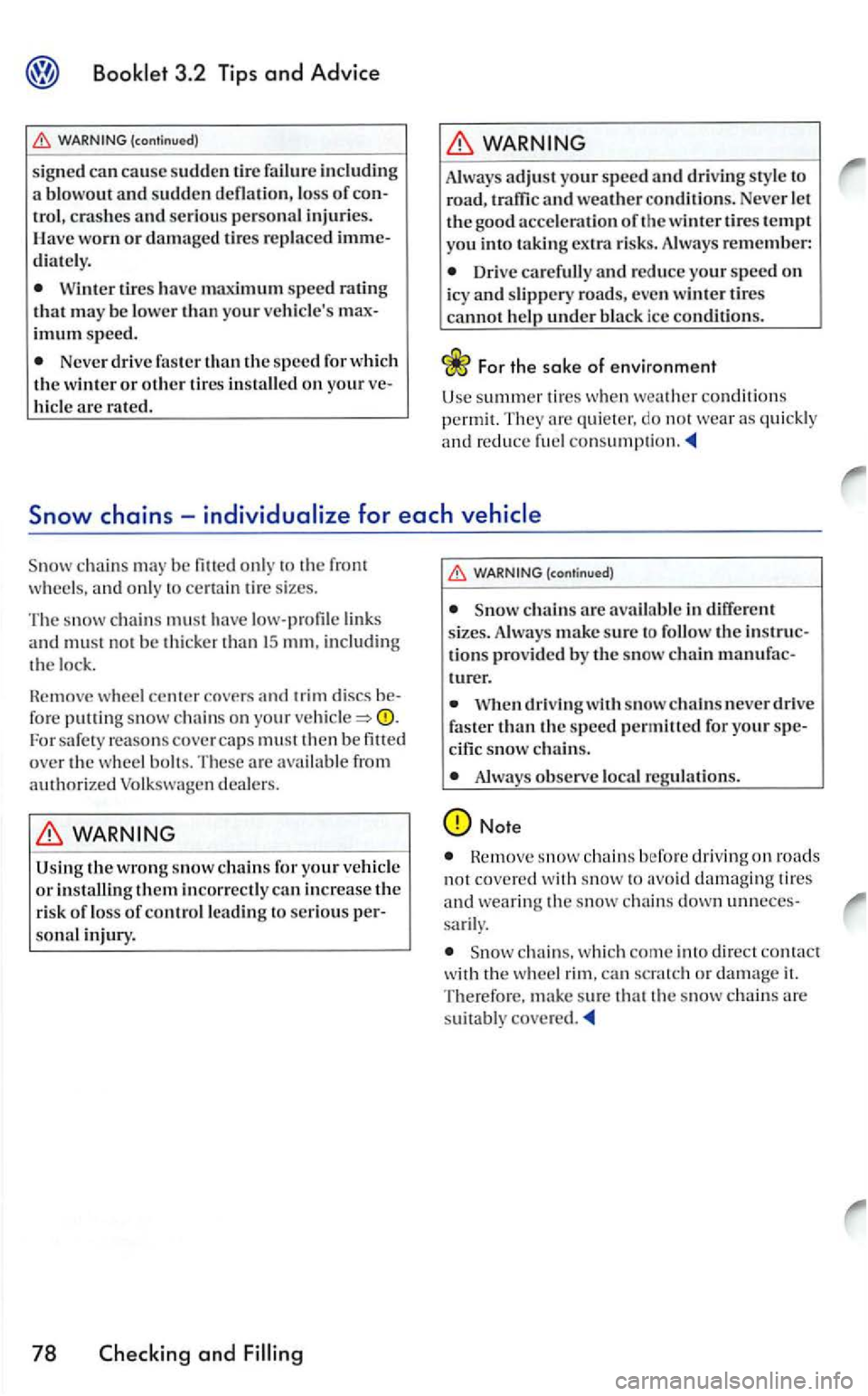
Booklet 3.2 Tips and Advice
loss of control, c rash es and serious personal injuri es. ave worn or d amage d tires rep la ce d immediate ly.
Wint er tires have maximum sp ee d rating
th at m ay be lo w er th an your vehicle's
imum sp ee d.
N ever drive faste r th an th e speed f or which the wint er or othe r tir es installe d on your ve
hicl e are rated.
Always adjus t your speed and driv in g style to
road , traffi c and wea ther co nditi ons. Ne ve r le t
th e good acce le ration of the w inter tires tempt yo u into ta kin g ex tra risk s. A lwa ys re m ember:
Dri ve care full y and reduc e your s p ee d o n
ic y slippery roads, eve n win te r tires cannot h elp unde r bl ack icc condition s.
For the sake of environment
summer ti re s w he n wea ther condit ions
perm it. They are qu ie te r. do not wear as qu ick ly and r ed uce fu el con sum ption.
Snow chains -for each
Snow ch ain s may be fitte d only to th e front
w heels, and onl y to ce rtain t ire sizes .
T he s n
ow ch ain s m ust h ave low -profile and m ust not be thick er than 15 mm. includ in g
t h e lock.
Remo ve w h
eel cente r co vPrs trim discs before pullin g snow ch ain s on yo ur vehicle=>
the wron g sno w chains for your vehicl e or installin g th em incorrectly can incre ase th e
ri sk of lo ss of cont rollc a din g to seri ous per
sonal injury.
78 Checking and Filling
(continued)
Snow c h ai ns a re available in diff ere nt
s izes. Alw ays make sure to follo w the in struc
ti o ns provid ed b y th e s now ch ain manufacturer.
s n ow chain s neve r dri ve
fast e r than th e speed p ermill ed for your sp e
cifi c snow chains.
Always ob serve loca l reg ulati ons.
H e m ove sn ow ch ains before driv in g on roa ds
not c ov ere d with sno w to av o id damagin g tires and weari ng the sn ow ch ain s down unneccs-sa ril y.